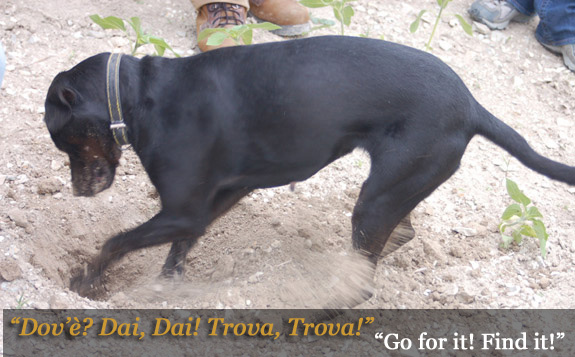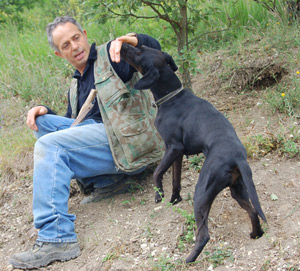Story by Kathryn Gregory
The mist clings lazily to the mountaintops
that overlook the fields of Acqualanga. An early morning haze subdues
the colors of the farmlands, creating the illusion of an old patchwork
quilt upon the landscape. Francesco Rotondo, 50, and his black dog Shelia
climb the worn dirt and gravel path up the side of a nameless Apennine
foothill until their truffle-hunting destination is reached.
The tartufo, or truffle, fields
are marked by an outcropping of oak trees, surrounded here by fields of
tall green stalks that will soon be bursting with sunflowers.
Yellow broom flowers curve along
the dirt path and outline the sunflower fields that dot the area where
the tartufi are found.
Shelia bounds happily along the
path, nose in the air, before her real work begins, while Rotondo follows
behind, trudging in his hunting boots and worn jeans that seem almost
yellowish with clay dust in the early morning light. A local blacksmith
made the truffle-digging spade that Rotondo has slung over his shoulder.
Its long worn, wooden handle and small pointed metal spearhead swings
lightly over his shoulder as he walks along the path.
Shelia runs around panting with
her tongue out and starts to focus on the ground. She runs in no particular
pattern and easily gets distracted by a chirping bird or a breeze rustling
the nearby bushes.
Acqualanga has not had much rain
this past season and the truffle crop is not very plentiful, Rotondo says.
“Many of the tartufi in the
fields are not very mature so there are not many strong odors for Shelia
to pick up,” Rotondo says,
The best place to find tartufi
is under oak trees at the base where there is no grass. The truffles emit
gases and enzymes into the grounds that kill nearby grass and weeds, he
says.
Truffles are small underground
mushrooms that are found in various regions across Italy and other parts
of Europe. There are many different types of tartufi, and they are used
in numerous Italian dishes. They add a unique flavor to sauces and soups
and are sometimes shaved raw over eggs and various pasta dishes.
Francesco walks behind Shelia and
settles himself into a spot near a small oak tree with cleared ground.
Shelia comes bounding over at the beckoning tone in Rotondo’s voice
as he encourages her to find the tartufi.

“Dov’è? Dai,
Dai! Trova, Trova!” he encourages Shelia. “Go for it! Find
it!”
There are five edible types of tartufi that are hunted and found in Acqualanga.
The white is the most precious and rare, bringing between $100 and $200
an ounce, depending on market conditions and quality. The others are strong
black, black, bianchetto, or little white, and scorzone. The white and
strong black are hunted in the late fall; on this June day Rotondo and
Shelia are hunting scorzone.
Rotondo, who is originally from
Calabria, moved to Acqualanga with his wife and two children about 10
years ago for a job as a middle school music teacher.
After Alba in Piemonte, Acqualanga is the Italian town most renowned for
truffle hunting and production.
Shelia’s whole front leans
forward, and she starts to frantically dig with her paws in the hard,
dusty earth. She rapidly creates a hole, large enough for her nose and
her front paws. She keeps digging, spraying dirt behind her through her
tautly muscled rear legs. She shifts her angle of excavation, all the
while with her nose pressed to the ground, sniffing out the tartufo.
Rotondo grabs his spade and starts to move some of the small rocks out
of the way to help Shelia dig for the little buried treasure.
She suddenly turns away, as if
all of her work was for nothing. Rotondo smiles.
He holds a small, black, almost rock-looking tartufo in his hand, about
the size of a walnut. He excitedly congratulates Shelia while he slowly
brushes the dirt off the tartufo between his coarse thumb and middle finger.
Shelia runs around him and places
her paws on his left side, near his camouflage vest pocket, sniffing around.
Her black, normally shiny nose and ears are covered in dust. Rotondo gives
her a small bit of cooked meat as a reward for finding a tartufo.
She knows that she has done a good
job and wags her tail as she starts to search the area for another truffle.
“Where you find one, you
find two or three,” Rotondo says as he fills the freshly dug hole
back up with dirt, observing proper truffle-hunting etiquette.
Shelia scouts the area and does
not seem to be picking up any scent. She travels over the same area three
times before wagging her tail and starting to dig again.
“The tartufo is breathing
underground. If you go by it when it is breathing, then you can scent
it. If it’s not breathing, you can’t,” Rotondo explains.
“You can go by the same place over and over again in five minutes
and only smell it once when it’s breathing.”

He
pulls some twigs out of Shelia’s way as she digs for her next find.
Rotondo has had 6-year-old Shelia
since she was one month old and trained her to be a tartufo hunting dog.
He would bury pieces of pork rind
in his yard and let Shelia hunt for the meat. Every day he would hide
the piece deeper and deeper to help train her to find truffles. Some can
be buried as deep as 20 inches underground.
When Shelia was able to find the
pork rinds, he would hide a piece of truffle with the meat to have her
recognize the smell. Eventually he removed the meat altogether, and she
sniffed out the truffle.
To prepare Shelia for truffle hunting,
Rotondo makes her fast for 24 hours so she is hungry for the hunt.
Since she was three months old,
Shelia has always had very successful hunting seasons, sometimes finding
hundred of grams of truffles in one month.
Last season, other tartufi hunters
from more than 40 kilometers away came to Rotondo and offered to buy Shelia
for $2,600.
He rejected the offer because she
is worth much more than that to him.
Rotondo normally makes around a
thousand dollars a season. His son, Michele, does most of the selling
after Rotondo brings home the truffles. He uses the money that he receives
to pay for his tartufo permit, and his game-hunting licenses. Rotondo
enjoys hunting cinghiale, or wild boar, and usually kills a couple every
year.
After he pays for his permits,
he has a little left over to take his family out for pizza or for Michele
and his daughter Angela to buy some clothes.
The summer tartufi season in Le
Marche is known as the scorzone season, which runs from June to August.
The most profitable truffle hunting season is in late fall and early winter,
when the bianco, strong black and black are found. The bianchetti sprout
in April.
No hunting is allowed in May and
September to let the crop replenish.

Some poachers hunt out of season
and make things more difficult for the law-abiders, he says. Poachers
have
been known to be jealous and guard the prime areas to find tartufo and
will slash other hunter’s tires to discourage them from climbing
up the mountain to the good hunting grounds.
“Tartufi are like gold,”
for some people, Rotondo says.
Rotondo and Shelia usually go hunting
early in the morning when many of the ticks, snakes, and other animals
that would be a danger to Shelia are less active. Rotondo knows men who
have lost a truffle hound to snakebites.
He takes another tartufo from Shelia’s
mouth and adds it to the three others found earlier in the morning.
The sun has moved higher in the
sky and the early morning cool air has vanished and been replaced with
a warm wind. A light rain starts to fall as Rotondo and Shelia head down
the path and away from the truffle fields, whose small delicacies will
remain undiscovered until another time.
Video by Kristen Conroy
Photos by Tami Dixon
Web Design by Melanie M Edwards
|

